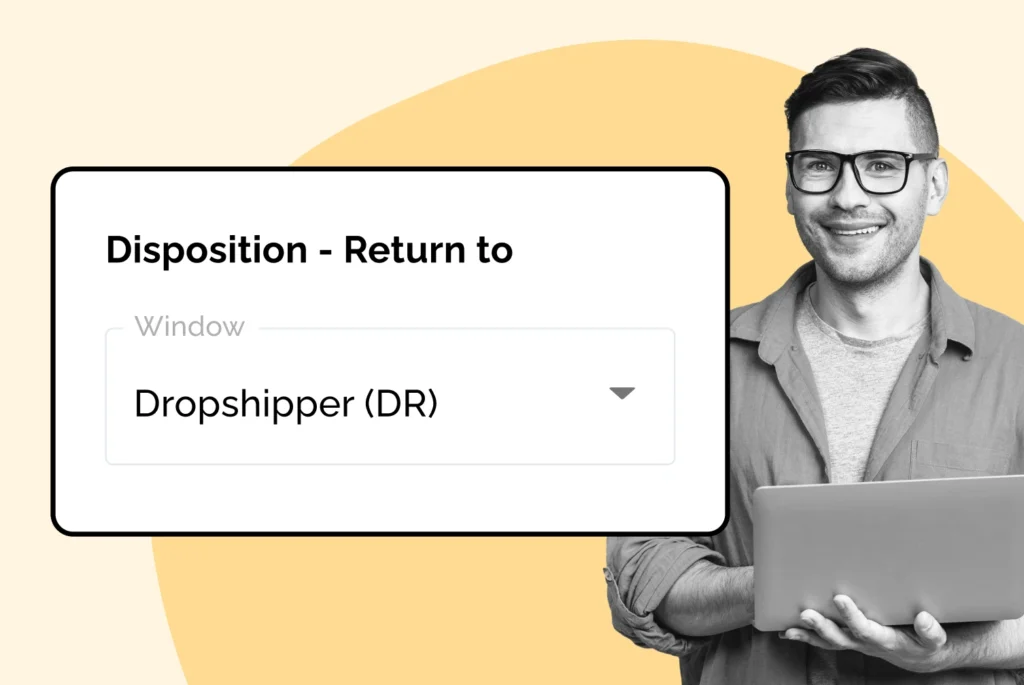
Sustainable Returns: How Online Brands Can Make Them
Let’s discuss practical strategies businesses can implement to manage the significant environmental impact of eCommerce returns!
Shipping, Tracking & Notifications
Boost customer experience and reduce support tickets
Realtime order and shipment tracking
Proactive order and shipping notifications
AI-Enhanced Discounted Labels
Predictive pre-purchase estimated delivery dates
Self-Serivce branded order tracking
Effortless experience delivered
Identify and Resolve Order Issues
Realtime order and shipment tracking
Make returns profitable and delight customers
Flexibility to define any return destinations & conditions
Simplify returns for your customers and team
Incentivize exchanges over returns
Returns management made easy for your team
Returns management made easy for your team
Easy claims and smart upsells
Understand why your customers are returning
In-Store & Curbside Pickup
Unify the online and the in-store experience
Hassle-free pickup experience for customers
In-Store dashboard to keep operations streamlined
In-Store and Online orders unified
Drive foot-traffic to your stores
Shipping, Tracking & Notifications
Boost customer experience and reduce support tickets
Realtime order and shipment tracking
Proactive order and shipping notifications
AI-Enhanced Discounted Labels
Predictive pre-purchase estimated delivery dates
Self-Serivce branded order tracking
Effortless experience delivered
Identify and Resolve Order Issues
Realtime order and shipment tracking
Make returns profitable and delight customers
Flexibility to define any return destinations & conditions
Simplify returns for your customers and team
Incentivize exchanges over returns
Returns management made easy for your team
Returns management made easy for your team
Understand why your customers are returning
In-Store & Curbside Pickup
Unify the online and the in-store experience
Hassle-free pickup experience for customers
In-Store Dashboard to keep operations streamlined
In-Store and Online orders unified
Drive foot-traffic to your stores
Boost customer experience and reduce support tickets
Realtime order and shipment tracking
Proactive order and shipping notifications
AI-Enhanced Discounted Labels
Predictive pre-purchase estimated delivery dates
Self-Serivce branded order tracking
Effortless experience delivered
Make returns profitable and delight customers
Flexibility to define any return destinations & conditions
Simplify returns for your customers and team
Incentivize exchanges over returns
Returns management made easy for your team
Equip your team for precise return checks.
Easy claims and smart upsells
Understand why your customers are returning
Unify the online and the in-store experience
Hassle-free pickup experience for customers
In-Store Dashboard to keep operations streamlined
In-Store and Online orders unified
Drive foot-traffic to your stores
Find the answer to all your questions
Take a step by step trip through our functionality to see how we can improve your ecommerce processes.
Explore the most comon questions about WeSupply
Calculate the ROI that WeSupply can bring you
Read actionable articles on how to optimize your post-purchase experience and decrease support tickets
Get inspired by stories of how our customers implemented an effortless post-purchase experience
Wondering if WeSupply is a good fit for you? Read through our use cases to see how we can help you increase conversion & improve CX!
A Deep Dive into Top Companies' Order Tracking & Returns Strategy
Find the answer to all your questions
Explore the most comon questions about WeSupply
Calculate the ROI that WeSupply can bring you
Request a no strings attached review of your current shopping experience and missed conversion opportunities
Take a step by step trip through our functionality to see how we can improve your ecommerce processes.
Read actionable articles on how to optimize your post-purchase experience and decrease support tickets
Get inspired by stories of how our customers implemented an effortless post-purchase experience
A Deep Dive into Top Companies' Order Tracking & Returns Strategy
Wondering if WeSupply is a good fit for you? Read through our use cases to see how we can help you increase conversion & improve CX!

Struggling with high product return rates? You might be sitting on a goldmine of insights that could help. Analyzing returns data can reveal why customers are unhappy and how you can enhance product descriptions with returns data to match their expectations. This approach not only reduces returns but also boosts customer satisfaction. In this article, we’ll show you how to transform returns data into a powerful tool for refining your product descriptions and improving your bottom line.
Returns data provides valuable insights into customer expectations and behavior, enabling eCommerce businesses to refine product descriptions and reduce return rates.
Identifying products with high return rates and analyzing customer feedback allows retailers to address common issues, improve product images, sizing charts, and descriptions, and align titles with customer expectations.
Automating data management enhances accuracy and efficiency, reducing errors in product information, improving the shopping experience, and supporting continuous improvement strategies for long-term success.
WeSupply uses returns data to enhance product descriptions by identifying high return rates and understanding reasons. Customers upload feedback and images, while key metrics like CSAT and NPS are tracked. Integrations with review platforms boost user-generated content, driving sales and trust. Get started with WeSupply today!
In recent years, the eCommerce landscape has experienced unprecedented growth, with more consumers than ever turning to online shopping for convenience and variety. However, this boom has brought with it a significant challenge: the surge in product returns. As online purchases continue to climb, so too does the number of items being sent back to retailers, creating a logistical and financial headache for businesses across the globe.
The impact of high return rates on eCommerce businesses cannot be overstated. Financially, returns can eat into profit margins, increase operational costs, and tie up inventory. But the repercussions extend beyond the balance sheet. High return rates can damage a brand’s reputation, erode customer trust, and hinder long-term growth. In an industry where customer loyalty is paramount, the ability to manage and reduce returns has become a critical factor in determining an online store’s success.
Diving further into this topic, we must recognize that the issue of product returns isn’t merely a problem to be resolved – it presents a chance for innovation and improvement. By analyzing returns data and using it to enhance product descriptions, eCommerce retailers can:
Reduce return rates
Improve overall customer satisfaction
Drive sales
Build a stronger, more resilient business.
The upcoming sections will delve into how returns data can be utilized to meet these objectives and revolutionize the operation of online stores in a fiercely competitive marketplace.
Returns data is a goldmine of information that provides invaluable insights into customer expectations and behavior. When a customer decides to return a product, they’re not just sending back an item – they’re communicating their unmet expectations, preferences, and pain points. By carefully analyzing this data, eCommerce businesses can gain a deeper understanding of what their customers truly want and need, allowing them to make informed decisions about product offerings, marketing strategies, and customer service improvements.
One of the most significant roles of returns data is its potential to improve product descriptions and, consequently, reduce future returns. By examining the reasons behind returns, businesses can identify gaps between customer expectations and the actual product received. This information can then be used to refine and enhance product descriptions, ensuring that they accurately represent the item’s features, dimensions, and functionality. When product descriptions are more precise and comprehensive, customers are better equipped to make informed purchasing decisions, leading to fewer mismatched expectations and, ultimately, fewer returns.
Moreover, the insights gleaned from returns data can have far-reaching effects beyond just product descriptions. They can inform inventory management decisions, guide product development, and even influence marketing campaigns. By leveraging this data effectively, eCommerce retailers can create a more seamless and satisfying shopping experience for their customers, fostering loyalty and encouraging repeat purchases. As we continue to explore the various ways returns data can be utilized, keep in mind that this information is not just about mitigating losses – it’s about unlocking new opportunities for growth and customer satisfaction.
One of the first steps in harnessing the power of returns data is identifying products with high return rates. This process allows eCommerce businesses to:
Narrow down their focus and prioritize improvements where they’re needed most
Analyze return-to-order ratios for individual products or product categories
Quickly pinpoint items that are causing the most customer dissatisfaction and financial strain
Grasping the return-to-order differentials is vital to evaluate the genuine impact of returns on your venture. While a product may have a high volume of returns, it’s essential to consider this in relation to its sales volume. For instance, a bestselling item might have a higher number of returns simply due to its popularity, but its return rate could still be lower than that of a less popular product. By focusing on the return rate rather than just the number of returns, businesses can more accurately identify problematic products and allocate resources effectively.
After identifying products with high return rates, the next step is to scrutinize the causes behind these returns. Are customers consistently citing sizing issues? Is there a mismatch between product images and reality? Are certain features not meeting expectations? By answering these questions, eCommerce retailers can develop targeted strategies to improve product descriptions, enhance product images, and address common customer concerns. This focused approach not only helps in reducing return rates for specific items but also contributes to overall customer satisfaction and loyalty across the entire product range.
WeSupply’s Return Analytics provides powerful insights to help businesses identify products with high return rates and understand the reasons behind these returns. By leveraging this tool, companies can pinpoint the most frequently returned products and uncover patterns or issues that lead to returns. Additionally, it identifies the most exchanged products, enabling businesses to address product quality, design, or customer expectations proactively.
Customer feedback from customer returns is a treasure trove of insights that can drive significant improvements in your eCommerce business. By systematically gathering and analyzing this feedback, retailers can gain a deeper understanding of customer expectations, preferences, and pain points. This process involves collecting data from various sources, including return reason codes, customer surveys, and open-ended comments.
One effective method for extracting valuable insights is to gather summary observations from return reasons. This involves categorizing and quantifying the most common reasons for returns, such as “size too small,” “color not as expected,” or “product damaged.” By identifying patterns in these reasons, businesses can prioritize areas for improvement in their product descriptions, images, and overall presentation.
However, the real gold often lies in the open-ended return comments provided by customers. These unstructured responses can offer more nuanced and specific feedback that might not be captured by predefined return reason codes. By carefully analyzing these comments, retailers can uncover unique insights into customer expectations and experiences. This qualitative data can be particularly useful in identifying subtle issues with product descriptions or uncovering unexpected use cases that might not have been considered.
To maximize the value of customer feedback, it’s essential to combine qualitative insights with quantitative data from analytics platforms. Tools like Google Analytics, Hotjar, and Lucky Orange can provide valuable behavioral data that complements the feedback gathered from returns. By integrating these various data sources, eCommerce businesses can develop a more comprehensive understanding of the customer journey and make informed decisions about product descriptions, marketing strategies, and overall user experience.
WeSupply enhances the ability to analyze customer feedback from returns by simplifying the process of collecting valuable insights. By allowing customers to upload images and provide detailed feedback directly on the branded returns page, businesses can gather crucial information efficiently. Additionally, WeSupply’s Logistics Analytics tools enable businesses to track and measure key metrics, ensuring a data-driven approach to improving the post-purchase experience.
Key features include:
WeSupply integrates with various review platforms such as Loox, Judge.me, Stamped, Yotpo, Okendo, Junip, and Reviews.io, enabling businesses to seamlessly collect and showcase customer reviews, user-generated content, and referrals, enhancing the overall feedback analysis and improving customer satisfaction.
By integrating with these review platforms, WeSupply enables businesses to enhance their ability to collect and analyze customer feedback, driving improvements in product offerings and customer satisfaction. The combination of detailed feedback collection and robust analytics tools ensures that businesses can make informed decisions to enhance the post-purchase experience.
Product titles hold a significant role in forming customer expectations and swaying buying decisions. Accurate and descriptive titles can significantly reduce the likelihood of returns by ensuring that customers have a clear understanding of what they’re buying before they make a purchase. By leveraging returns data, eCommerce businesses can refine their product titles to better align with customer expectations and reduce the risk of misunderstandings.
Consider a scenario where a high number of returns are attributed to customers receiving a product that doesn’t match their expectations based on the title. For example, a clothing item titled “Lightweight Summer Jacket” might be returned frequently because customers find it too heavy for summer wear. By analyzing the return reasons and customer feedback, the retailer could revise the title to “Mid-Weight Spring/Fall Jacket” to more accurately reflect the product’s characteristics. This simple change can help set the right expectations and reduce returns due to misunderstandings.
For efficiently utilizing returns data to refine product titles, eCommerce businesses ought to:
Identify products with high return rates due to title-related issues.
Analyze customer feedback and return reasons related to these products.
Look for patterns in the misunderstandings or mismatched expectations.
Revise titles to be more accurate, descriptive, and aligned with customer expectations.
Monitor the impact of title changes on return rates and customer satisfaction.
By implementing this data-driven approach to product title optimization, retailers can create more accurate product content, improve the overall shopping experience, and ultimately reduce return rates. Remember, a well-crafted title is often the first point of contact between a customer and a product, making it a critical element in the journey to reduce returns and boost customer satisfaction.
Closed-ended questions keep surveys short and to the point, ensuring higher response rates and more actionable data.
WeSupply empowers eCommerce businesses to leverage returns data for personalized recommendations, enhancing customer satisfaction and reducing return rates. By providing detailed returns analytics and logistics insights, WeSupply helps businesses understand why customers return products, identify serial returners, and measure customer satisfaction. This data-driven approach enables businesses to make informed decisions and offer personalized recommendations that meet customer needs.
Top-notch product images along with precise sizing charts are indispensable tools in forming customer expectations and decreasing returns. Returns data can provide valuable insights into how well your current visual content is performing and where improvements can be made. By analyzing return reasons related to product appearance or fit, eCommerce retailers can identify areas where their images or sizing information may be falling short.
When it comes to product photography, the goal should be to provide a comprehensive and accurate visual representation of the item. This might include multiple angles, close-up shots of important details, and images of the product in use or worn by models of various sizes. If returns data indicates that customers are frequently surprised by certain aspects of a product’s appearance, it’s a clear sign that these features need to be better highlighted in the product images. For example, if a significant number of returns for a piece of furniture cite “color not as expected,” it may be necessary to improve the color accuracy of the images or provide additional photos in different lighting conditions.
Sizing charts are particularly crucial for reducing returns in the fashion and apparel industry. Returns data can reveal which products are most frequently returned due to sizing issues, allowing retailers to focus on improving the accuracy and clarity of their sizing information for these items. This might involve:
Providing more detailed measurements for specific body parts.
Including fit recommendations based on customer feedback (e.g., “runs small, consider sizing up”).
Offering interactive sizing tools that use customer input to suggest the best size.
Showing the product on models of different body types and sizes.
WeSupply’s Return Analytics helps businesses enhance their product offerings by providing detailed insights into return reasons at the SKU level. By identifying issues related to color, quality, and size, businesses can make informed adjustments to their product images and sizing charts. This ensures that customers receive accurate information, leading to reduced return rates and improved satisfaction.
Key features include:
Simplify Returns for Your Customers and Support Team
Book a quick call with our experts to see how WeSupply can help you: simplify the Return experience with just a few clicks, reduce customer service calls and manual processing, notify your customer about their refund, automate returns and reduce user error
Precise and comprehensive accurate product descriptions serve as the pillar of thriving eCommerce operations, they drive conversions and guarantee customer satisfaction. Returns data can be an invaluable resource for identifying areas where product descriptions may be falling short or misleading customers. By analyzing the reasons behind returns and customer feedback, retailers can refine their product descriptions to provide more precise, comprehensive, and relevant information, ultimately leading to enriched product data.
Overstating or exaggerating product features is a common trap in poor product descriptions. While it may be tempting to use superlatives or make grand claims about a product’s capabilities, this approach can often lead to disappointed customers and increased returns. Instead, focus on providing clear, factual information about the product’s features, materials, dimensions, and intended use. If returns data indicates that customers are frequently misunderstanding certain aspects of a product, it’s a sign that these areas need more detailed or clearer explanations in the description.
To create effective product descriptions that drive conversions and reduce returns, follow these steps:
Use clear, concise language that accurately describes the product’s features and benefits.
Include specific details about materials, dimensions, care instructions, and any limitations or requirements.
Address common questions or concerns that emerge from returns data.
Use bullet points or short paragraphs to improve readability and highlight key information.
Incorporate customer feedback and testimonials to provide real-world context and set accurate expectations.
Regularly update descriptions based on returns data and customer feedback to ensure ongoing accuracy and relevance.
By implementing these strategies and continuously refining product descriptions based on returns data, eCommerce retailers can create a more transparent and informative shopping experience. This not only helps in reducing returns but also builds trust with customers, encouraging repeat purchases and positive word-of-mouth recommendations.
Customer reviews and preferences are treasure troves of information that can be harnessed to refine product descriptions and produce more accurate content. By analyzing the language and focus points in positive reviews, eCommerce retailers can identify the features and benefits that resonate most with satisfied customers. Conversely, negative reviews can highlight areas where product descriptions may be lacking or misleading. This valuable feedback can be used to update and improve product content, ensuring that it aligns with real customer experiences and expectations.
Real-world examples of successful implementations of this strategy abound. For instance, a clothing retailer noticed a high return rate for a particular jacket, with many customers citing that it wasn’t as warm as expected. By incorporating this feedback into the product description, emphasizing that the jacket is best suited for mild weather and layering, the company saw a significant decrease in returns and an increase in customer satisfaction. Similarly, a tech company found that highlighting specific compatibility information prominently in their product descriptions, based on customer questions and returns data, led to fewer returns due to incompatibility issues.
To effectively leverage customer preferences for accurate content, follow these steps:
Regularly monitor and analyze customer reviews and feedback.
Identify common themes in both positive and negative reviews.
Use the language and terminology that customers frequently use to describe the product.
Update product descriptions to address common concerns or highlight frequently praised features.
Consider creating FAQ sections based on recurring customer questions or issues.
Implement A/B testing to determine which description elements resonate best with customers.
WeSupply’s integrations with powerful review platforms help businesses leverage customer preferences for accurate and engaging content. By connecting with platforms like Loox, Judge.me, Stamped, Yotpo, Okendo, Junip, and Reviews.io, businesses can effortlessly collect and display user-generated content, including reviews, ratings, and referrals. This ensures that customer feedback is accurately reflected, driving sales and enhancing customer trust.
Key features include:
In the dynamic environment of eCommerce, manually managing a large volume of ecommerce product data isn’t practical anymore. Automated systems for managing product data offer numerous benefits, including reduced errors, improved efficiency, and enhanced customer satisfaction. By implementing automated data management solutions, eCommerce businesses can ensure that their product information remains accurate, up-to-date, and consistent across all channels.
One of the key advantages of automation in product data management is the reduction of human error. Manual data entry and updates are prone to mistakes, which can lead to inaccurate product descriptions, pricing errors, or outdated information. These errors can result in customer dissatisfaction and increased returns. Automated systems, on the other hand, can pull data from various sources, update information in real-time, and maintain consistency across multiple platforms, significantly reducing the risk of errors and improving overall data accuracy.
Moreover, automation can greatly enhance operational efficiency in managing product data. With artificial intelligence and machine learning capabilities, these systems can:
Automatically categorize and tag products based on their attributes.
Generate product descriptions using predefined templates and data points.
Update inventory levels and pricing information in real-time across multiple channels.
Flag potential issues or inconsistencies in product data for review.
Analyze returns data to identify trends and suggest improvements to product information through product data enrichment.
By leveraging ecommerce product data enrichment and its automated capabilities, eCommerce businesses can:
Improve the accuracy of their product information
Free up valuable time and resources
Focus on more strategic tasks, such as analyzing customer feedback and implementing data-driven improvements to reduce return rates and enhance overall customer satisfaction.
In the constantly changing realm of eCommerce, the adoption of continuous improvement strategies is vital for maintaining competitiveness and fulfilling customer expectations. Ongoing analysis and updates to product descriptions ensure that the information remains accurate, relevant, and aligned with customer needs. By adopting a culture of continuous improvement, eCommerce businesses can proactively address issues, capitalize on opportunities, and consistently enhance the customer experience.
For implementing successful continuous improvement strategies, retailers should employ a mix of tools and techniques. These may include:
Regular data analysis: Consistently review returns data, customer feedback, and sales metrics to identify trends and areas for improvement.
A/B testing: Experiment with different product descriptions, images, or layouts to determine which versions perform best in terms of conversions and reduced returns.
Customer surveys: Periodically gather direct feedback from customers about their shopping experience and product satisfaction.
Competitor analysis: Keep an eye on industry trends and competitor practices to stay ahead of the curve.
Cross-functional collaboration: Encourage communication between teams (e.g., marketing, product management, customer service) to share insights and implement improvements holistically.
By employing these tools and techniques, eCommerce businesses can create a systematic approach to continuous improvement.
Note that continuous improvement isn’t a one-off endeavor but a persistent process. Retailers should establish regular review cycles to assess the effectiveness of implemented changes and identify new areas for improvement. This iterative approach allows businesses to adapt quickly to changing customer preferences, market trends, and technological advancements.
By consistently refining product descriptions and optimizing the overall shopping experience, eCommerce retailers can build stronger customer relationships, reduce return rates, and drive long-term success in the competitive online marketplace. One key aspect of this success is having a well-designed ecommerce store that effectively showcases these product descriptions and provides a seamless user experience.
Aside from its powerful analytics, WeSupply offers several features to enhance the post-purchase experience:
Branded Returns Portal to Boost Customer Loyalty: Create a branded, omnichannel experience instead of redirecting customers to third-party courier pages.
Self-Service Returns Process: Provide a frictionless eCommerce returns experience, giving customers complete control over the return process.
Create Flexible Returns Rules: Develop hassle-free return policies tailored to various use cases, maximizing return logic efficiency.
Autogenerated QR Code Return Labels: Simplify returns by allowing customers to scan a QR code from their email, eliminating the need for printing.
Returns Tracking: Enable customers to track the progress of their returns and check statuses easily.
Post-Purchase Email & SMS Notifications: Utilize notifications with open rates as high as 98% to send return shipping updates and personalized deals.
WeSupply can integrate with hundreds of third-party tools, connecting order and returns data to your existing API-driven tools, enhancing customer experiences and saving money.
Keep your customers engaged during the delivery experience
Book a quick call with our experts to see how WeSupply can help you engage your customers with relevant updates through the right channel, at the right time.
As we’ve discovered in this blog post, utilizing returns data to enhance product descriptions could provide extensive benefits for eCommerce businesses. One of the most significant long-term advantages is the enhancement of customer loyalty. When customers consistently receive products that meet or exceed their expectations, they’re more likely to develop trust in your brand and become repeat shoppers. This increased loyalty not only leads to higher customer lifetime value but also reduces acquisition costs, as satisfied customers are more likely to recommend your store to others.
Moreover, the efforts to reduce product returns through improved descriptions and data management can have a substantial impact on your bottom line. By minimizing returns, businesses can sustain healthier profit margins, as they reduce the costs associated with processing returns, restocking items, and potential product depreciation. This financial benefit extends beyond just cost savings; it allows companies to allocate resources more effectively towards growth initiatives, product development, and customer experience enhancements.
Perhaps one of the most valuable long-term benefits is the improvement in brand image and reputation. In today’s interconnected digital world, a company’s reputation can spread quickly through social media and online reviews. By consistently delivering products that align with customer expectations, businesses can cultivate a positive brand image associated with reliability, transparency, and customer-centricity. This enhanced reputation not only attracts new customers but also strengthens relationships with existing ones, creating a virtuous cycle of growth and customer satisfaction.
Throughout this blog post, we’ve delved into the multifaceted approach of using returns data to enhance product descriptions and ultimately reduce return rates in eCommerce. From identifying high-return products and analyzing customer feedback to refining product titles, images, and descriptions, we’ve explored a comprehensive strategy for leveraging data to improve the online shopping experience. We’ve also discussed the importance of automating data management and implementing continuous improvement strategies to stay ahead in the competitive eCommerce landscape.
WeSupply enhances product descriptions using returns data by identifying high return rates and understanding return reasons. With Return Analytics, businesses can address product issues and improve quality, design, and customer expectations. Customers can upload images and feedback on a branded returns page, streamlining feedback collection. Key metrics like Customer Satisfaction (CSAT) and Net Promoter Score (NPS) are tracked for continuous improvement. SKU-level insights help adjust sizing charts and product images. Integrations with review platforms such as Loox, Judge.me, Stamped, Yotpo, Okendo, Junip, and Reviews.io enable businesses to collect and display user-generated content, driving sales and trust. Get started with WeSupply today and transform your product descriptions with valuable returns data!
To identify products with high return rates in your eCommerce store, analyze the return-to-order ratios for individual products or categories and focus on the return rate percentage rather than just the number of returns. Utilize your eCommerce platform’s analytics tools or integrate a returns management system to track these metrics effectively.
To effectively gather and analyze customer feedback from returns, implement structured return reason codes, provide open-ended comment fields, conduct post-return surveys, analyze customer service interactions, and use text analysis tools. It’s important to combine qualitative data with quantitative analytics for a comprehensive understanding.
WeSupply’s Return Analytics provides powerful insights to identify products with high return rates and understand the reasons behind these returns. This helps pinpoint frequently returned products and uncover patterns or issues leading to returns.
WeSupply simplifies the process by allowing customers to upload images and provide detailed feedback directly on the branded returns page. This collected information is crucial for understanding customer issues efficiently.
WeSupply’s Logistics Analytics tools track key metrics such as Customer Satisfaction (CSAT) and Net Promoter Score (NPS), ensuring a data-driven approach to improving the post-purchase experience.
Yes, WeSupply does have an official Shopify App. You can download and begin to integrate it with your Shopify store.
Yes, WeSupply has an official extension for Magento. The WeSupply x Magento integration allows for automating order tracking experiences, reducing customer inquiries, automating shipping email and SMS notifications, and providing a fully branded order tracking experience
Yes, WeSupply has an official BigCommerce App. You can integrate WeSupply with your BigCommerce store to improve your post-purchase customer experience.

Learn How To Create Successful Post Purchase Email Campaigns
Build an effective post-purchase email flow that helps you increase customer satisfaction and drive revenue growth!
Consumers seek the best deals on:

Let’s discuss practical strategies businesses can implement to manage the significant environmental impact of eCommerce returns!

Ler’s explore strategies like carbon offsetting, bulk shipping, and returnless refunds to achieve sustainable performance!

This article will show you how to optimize the sales and return process for swimwear, boosting customer satisfaction and revenue!

Practical strategies to optimize returns and exchanges for online furniture stores, helping reduce costs and improve customer satisfaction.

This article unpacks how pre-paid labels can both improve the return experience for customers and streamline operations for retailers.

Discover through our comprehensive guide how recommerce is reshaping the retail space, driving economic value, and fostering environmental sustainability.

Managing dropshipping returns requires clear, actionable strategies. Turn them into a source of customer trust rather than frustration!
Let’s explore how tracking systems can enhance customer satisfaction, improve operational efficiency, and provide valuable business insights!

Learn the tangible benefits this integration delivers, as we unpack the advantages and practical steps of merging these powerful tools.